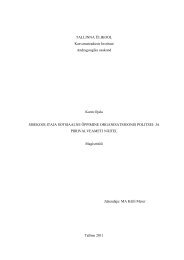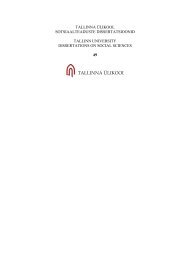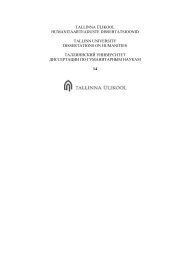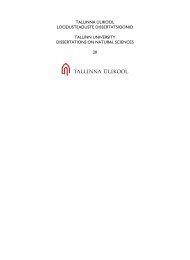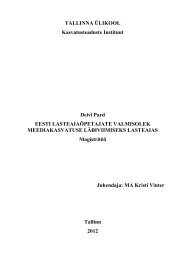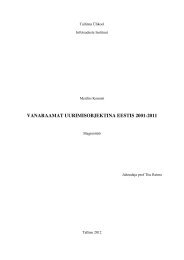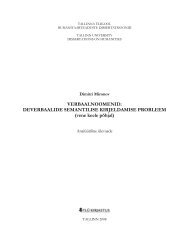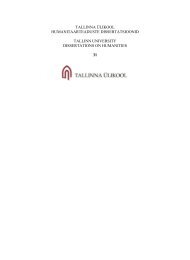You also want an ePaper? Increase the reach of your titles
YUMPU automatically turns print PDFs into web optimized ePapers that Google loves.
The present study is about Uus-Pärnu, a small town in Livonia at the end of the Middle Agesand the beginning of the Early Modern Age. The decision to limit the research to Uus-Pärnu(New Pärnu) excluding the Episcopal Vana-Pärnu (Old Pärnu) on the opposite side of the PärnuRiver has been deliberate emphasizing the fact even professional historians tend to forget: in theMiddle Ages these two were separate towns. The history of Vana-Pärnu would be more tellingif studied independently or together with the other towns of the Saare-Lääne bishopric. Ofcourse, the phenomenon of the double city cannot be ignored but that would imply the study ofcontacts and communication between the two. It is only in this context that Vana-Pärnu hasbeen discussed also in the present thesis.The time frame for the discussion is by and large the first half of the 16 th century (1500–1558/62). The period is initiated by the victorious war of Wolter von Plettenberg, the masterof the order, against Russians, and it comes to its end together with the end of Livonia’sindependence and the annihilation of the government of the Order at the outbreak of theLivonian War (1558/1562). The last fifty years of the independence includes a number ofmomentous events in the history of Livonia, and of Europe. The most important among theseis undeniably the Reformation, shattering the foundations of the church, the state and thesociety in Europe. It challenged also the Livonian estates and the statehood that left thechallenge unanswered unable to realize it to the benefit of their country. So the Reformationand secularisation has to be the axis of the study determining one of its aims: to describe andanalyze the process of secularization in the small town and its impact on the mode of life.The thesis is divided into seven chapters with their contents determined largely by theavailability of sources, i.e. researching the fields recorded sufficiently in the town registerbooks. Another concern has been to have as integral a survey of the life and citizens of a smalltown as possible. To surpass a narrow compass treating Uus-Pärnu as a thing-in-itself the townhas been compared to other smaller or bigger Livonian towns, and to other cities in Europe. It isonly the wide comparative basis that enables to find and state the major traits typical of theLivonian small town and its way of life. The prerequisite, of course, being the latter has beenexistent. At the same time the thesis tries to spot and explain the role a small town could play inthe social, economical and cultural processes in Livonia at the late Middle and the EarlyModern Age. Chapter 1 is on Uus-Pärnu and its citizens in the first half of the 16 th century, or tobe more precise, on the look of the town and the developments in its space. It also studies thesocial and national composition of the citizens and their regional background. Relations withthe landlord were of key importance for any town, so the next chapter is about the relationsbetween Uus-Pärnu and the Livonian Order or the Pärnu Commander as the Order’s localrepresentative. Next the focus is on the composition and activities of the municipal government,the town council. The central issue is to characterize the government and administration of asmall town. The next two chapters are dedicated to the two dominant estates, the merchants andthe craftsmen. They characterize the trade and the handicraft of Uus-Pärnu. The chapters tofollow are on family, marriage and women in the city community. The final chapter of thethesis is about ecclesiastical and religious life before and after the Reformation, and about theevents of the Reformation in Uus-Pärnu.The scantiness of sources makes the research of small towns on the territory of Estonia in theMiddle and the Early Modern Age a convoluted and sometimes even an impossible task.Although the absence of written records can be at times compensated by archaeologicalfindings, there are fields and subjects that are reflected in written records only. Tallinn is theonly Estonian town possessing rich archival sources on its early history. Even Tartu, anotherhanseatic town, has been left with only little material. The situation is even worse with olderarchives of other small towns. The case of Uus-Pärnu, however, is lucky in the sense it hasseveral town registers of the 16 th century. Of course, the town registers are not the only written227




